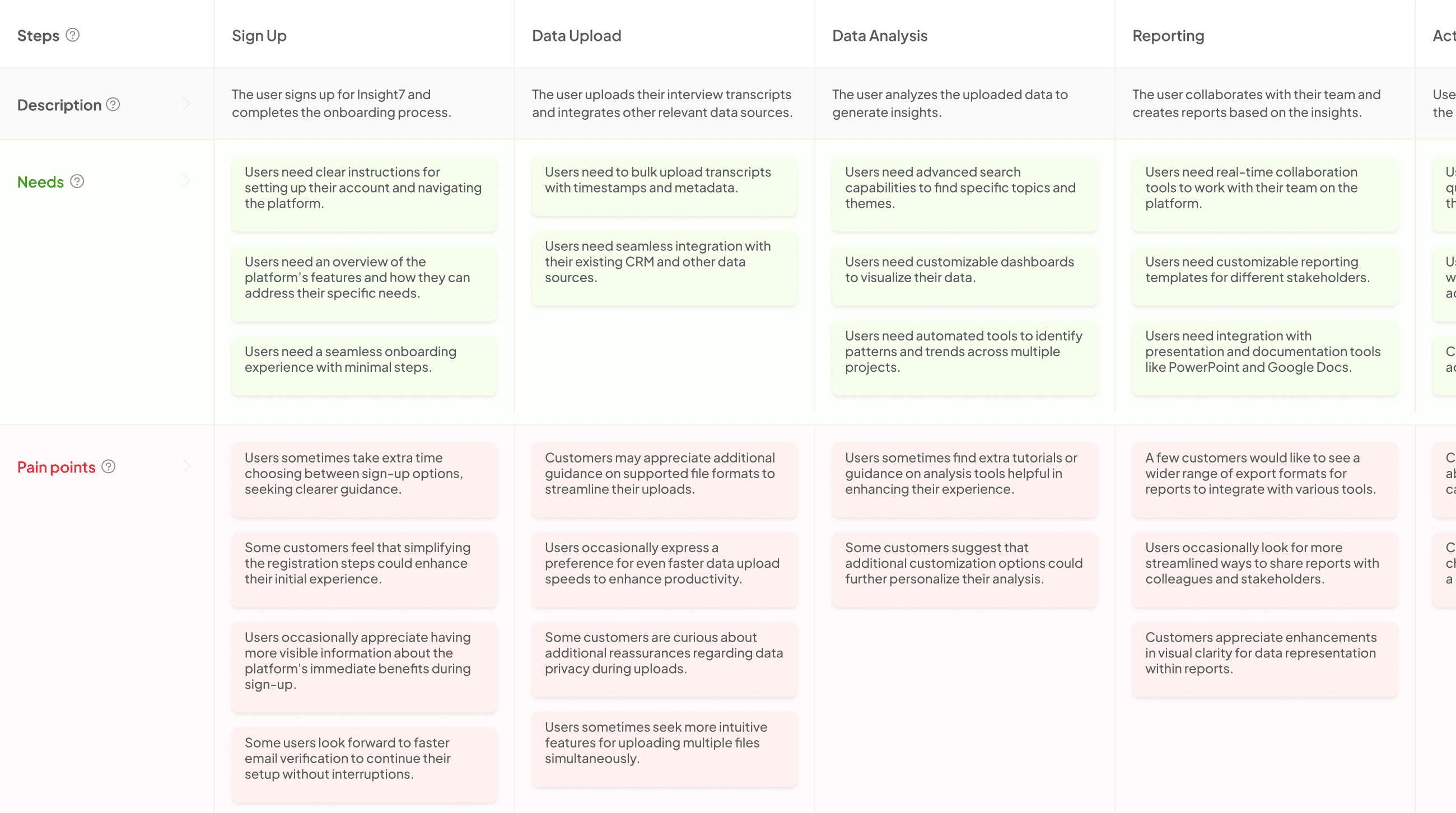Best AI tools for generating journey maps from user testing interviews
-
Bella Williams
- 10 min read
In today's competitive landscape, understanding user experiences is paramount for product development. Journey mapping tools play a crucial role in this process, transforming user testing interviews into insightful visualizations. These tools help capture each step of the user's interaction, revealing their needs, pain points, and the overall journey. By employing these tools, teams can identify friction points that may hinder user satisfaction, ultimately guiding them towards better design decisions.
Utilizing journey mapping tools not only enhances the understanding of the user experience but also fosters effective communication among stakeholders. As organizations strive for user-centric approaches, these tools serve as invaluable resources, enabling teams to visualize and analyze user feedback systematically. Exploring the right journey mapping tools can elevate the quality of insights gathered from user testing interviews, leading to more informed and impactful decisions.
Extract insights from Customer & Employee Interviews. At Scale.

Exploring Journey Mapping Tools for Effective User Insights
Selecting the right journey mapping tools is essential for uncovering effective user insights. These tools help visualize the experiences of users at each stage of their interaction, from initial research to final decision-making. By transforming user testing interviews into interactive maps, organizations can better identify pain points and areas for enhancement within the customer journey.
To explore these tools effectively, it’s important to consider key aspects that enhance their usability and effectiveness. First, look for tools that offer intuitive visualization options, allowing teams to easily map out complex journeys. Second, ensure that the selected tools integrate seamlessly with data sources to streamline the collection of user feedback. Finally, prioritize tools that facilitate collaborative efforts, enabling various stakeholders to contribute insights and recommendations. By focusing on these features, organizations can maximize the potential of journey mapping tools for gathering valuable user insights.
Key Features of Insight7 for Journey Mapping
Insight7 offers an array of features tailored specifically for journey mapping, enabling users to visualize the customer experience efficiently. One standout capability is its ability to transform raw interview transcripts into comprehensive visual maps. This process reveals friction points and customer pain areas throughout the entire journey—from initial research to post-purchase analysis. Such visualizations help organizations grasp how customers interact with their products and services, leading to more actionable insights.
Another crucial feature is the platform's ability to generate detailed recommendations based on the analyzed data. By utilizing sophisticated AI-driven analytics, the tool identifies trends and suggests strategic improvements. These insights enable teams to better understand user needs and enhance their overall service offerings. As a powerful journey mapping tool, Insight7 stands out by delivering not just data but structured, meaningful narratives that guide organizations in refining their customer experiences.
Additional AI Tools for Generating Journey Maps
In the realm of journey mapping, various AI tools enhance the process, transforming complex interview data into visual representations of user experiences. These tools serve to pinpoint user pain points and highlight opportunities for improvement. By leveraging advanced algorithms, additional AI tools for generating journey maps can efficiently analyze user interactions at every touchpoint, offering invaluable insights into customer behavior.
One notable addition is sentiment analysis software that interprets user emotions expressed during interviews. This tool can guide you in understanding the feelings tied to specific experiences. Another useful solution is automated visual mapping tools, allowing users to create visual journey maps swiftly. These tools compile data from multiple sources, enabling a clear overview of the entire user journey. Ultimately, integrating such AI-driven journey mapping tools can elevate your understanding of user needs and enhance the overall design process, leading to more thoughtful and impactful solutions.
Steps for Creating Journey Maps Using AI Tools
Creating journey maps using AI tools involves a structured approach to ensure comprehensive user insights. The first step is to collect and analyze data from user testing interviews. Gather qualitative insights through direct interviews and focus groups, identifying key pain points and user needs. This data serves as the foundation for generating meaningful journey maps.
Next, utilize AI-driven journey mapping tools to create visual representations of the user experience. These tools can automate the process, transforming transcripts and feedback into accessible visual formats. By mapping out each stage—from research to decision-making—you can uncover friction points and better understand customer behavior. Recommendations can then be integrated directly into the journey maps, ensuring that the insights lead to actionable changes in the user experience. By following these steps, you can effectively utilize journey mapping tools to enhance user understanding and improve overall service delivery.
Generate Journey maps, Mind maps, Bar charts and more from your data in Minutes
Step 1: Collecting and Analyzing User Testing Interviews
Collecting and analyzing user testing interviews is pivotal for crafting effective journey maps. Begin by thoroughly gathering interview data, which can reveal deep insights into user experiences and pain points. Ensure you document each interaction clearly, either through recordings or detailed notes, capturing verbal and non-verbal cues that illuminate user sentiments. This comprehensive collection lays the foundation for robust analysis, enabling you to identify key themes and trends in user behavior.
Once data is collected, the next step is analysis. Organize the information into categories that reflect different stages of the user journey. Look for recurring patterns, emotional highs, and lows expressed by users. This structured approach not only helps in creating a visual journey map but also enriches the understanding of user needs. By using the right journey mapping tools, you can effectively transform these insights into actionable strategies that enhance user experiences and drive product improvement.
Step 2: AI-Driven Journey Map Creation
In the process of AI-driven journey map creation, the primary goal is to visualize key user experiences and pain points effectively. By leveraging advanced technology, teams can transform comprehensive user testing interviews into insightful journey maps. This visualization illustrates the user's entire experience, from initial research through to decision-making, highlighting essential touchpoints that outline both challenges and opportunities.
To create an effective journey map, several elements should be considered: first, gather and structure insights from user interviews to identify patterns in behavior and sentiment. Second, utilize AI-powered journey mapping tools to generate visual representations of these insights, ensuring that every phase of the user's journey is captured. Lastly, continually modify the maps by integrating new data, which helps maintain accuracy and relevance over time. By following these steps, teams can create tools that not only enhance their understanding of user experiences but also inform strategic decisions that drive improvements in products and services.
Conclusion: Maximizing Insights with Journey Mapping Tools
Maximizing insights with Journey Mapping Tools is crucial for understanding user experiences and identifying pain points effectively. By transforming raw interview data into visual representations, these tools allow teams to pinpoint areas needing improvement throughout the user journey. They provide a structured way to analyze user behavior from research through to decision-making, ensuring that no critical insight is overlooked.
The impact of Journey Mapping Tools extends beyond mere visualization; they foster collaboration and informed decision-making. When teams leverage these insights, they can tailor offerings to better meet user needs, ultimately enhancing the overall experience. Embracing these tools not only leads to more actionable insights but also establishes a foundation for ongoing user-centered improvements.







